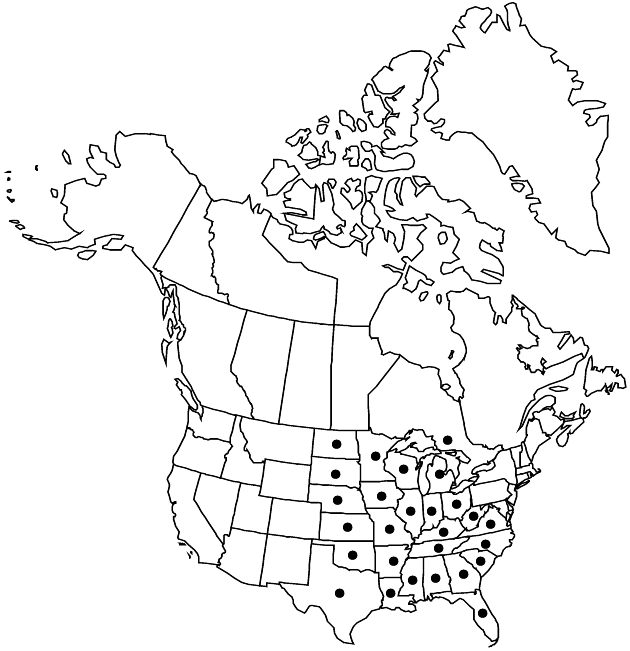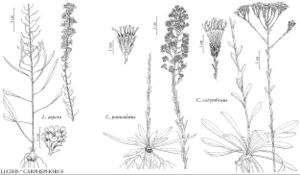Liatris aspera
Fl. Bor.-Amer. 2: 92. 1803.
Plants 30–180 cm. Corms globose. Stems hispidulous-puberulent. Leaves: basal (usually withering before flowering) and proximal cauline 1-nerved, broadly oblanceolate to elliptic or lanceolate-spatulate to linear-lanceolate, 80–250 × (4–) 6–25 mm, gradually or abruptly reduced distally, essentially glabrous or sparsely or densely puberulent-hispidulous, ± glanddotted (distal especially). Heads in loose, spiciform arrays. Peduncles 0 or (ascending to spreading or deflexed) 1–5 (–10) mm. Involucres campanulate-hemispheric to turbinate-campanulate, (9–) 10–16 × 10–20 mm. Phyllaries usually in 4–5 series, (outer or outer and middle usually reflexed) broadly obovate to oblong-spatulate, unequal, essentially glabrous, margins with relatively broad, whitish-hyaline, irregular to erose or lacerate borders (especially on the distal 1/3), strongly bullate (with a sharp, low, rounded buttress delimiting the hyaline border), apices usually rounded to subtruncate. Florets (14–) 18–24 (–30); corolla-tubes pilose inside. Cypselae (3.5–) 4.5–6 mm; pappi: lengths ± equaling corollas, bristles barbellate. 2n = 20.
Phenology: Flowering Aug–Sep(–Oct).
Habitat: Prairies, barrens, old fields, sand dunes, ridges, fields, stream bottoms, sandstone outcrops, limestone ridges, hills, oak, oak-juniper, and oak-pine woodlands, jack pine, sand, silt loam
Elevation: 50–500(–900) m
Distribution

Ont., Ala., Ark., Fla., Ga., Ill., Ind., Iowa, Kans., Ky., La., Mich., Minn., Miss., Mo., Nebr., N.C., N.Dak., Ohio, Okla., S.C., S.Dak., Tenn., Tex., Va., W.Va., Wis.
Discussion
Plants of Liatris aspera from the Dakotas, Minnesota, Nebraska, Iowa, and Kansas have consistently sparsely to densely puberulent-hispidulous leaves (var. aspera); those to the east usually have glabrous leaves (var. intermedia); variation in vestiture occurs in Missouri, Illinois, and Indiana and identities in this large area would have to be arbitrary or typological if varieties were formally recognized. Variety salutans was recognized by Shinners on the basis of its deflexed (versus horizontal or ascending) heads; such plants occur in Texas, western Louisiana, and adjacent areas of Arkansas and Oklahoma.
Selected References
None.
Lower Taxa
"barbellate" is not a number."fine" is not a number.
